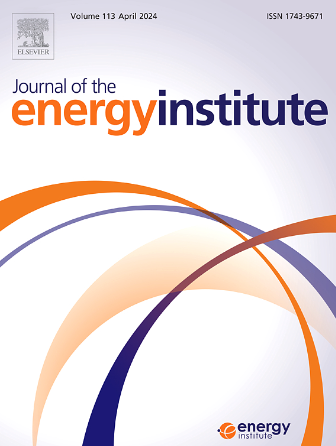An evaluation of the performance and catalytic mechanism of high-temperature-induced Ni/Al2O3 in the hydrodeoxygenation of lignin
IF 5.6
2区 工程技术
Q2 ENERGY & FUELS
引用次数: 0
Abstract
Selectively converting lignin is advantageous for the advancement of renewable energy. Strong metal-support interaction (SMSI) in a catalyst significantly influences its catalytic activity during lignin conversion. Therefore, reasonable regulation of SMSI can effectively enhance the catalyst activity. Nickel layered double hydroxide (Ni-LDH) was prepared by in-situ method. An induced oxidation strategy, which involves regulating the surface reconstruction process of the catalyst by controlling the oxidation temperature during the oxidation stage, was also revealed. Consequently, Ni/Al2O3-600, featuring SMSI, was successfully prepared and demonstrated effective catalysis in the hydrodeoxygenation (HDO) of lignin into cyclanes. Ni/Al2O3-600, prepared at the optimal calcination temperature of 600 °C, exhibits on high activity for the HDO of lignin, achieving a soluble portion yield of 95.3 %. Furthermore, the lignin-related model compound phenoxyethylbenzene (PEB) was completely converted over Ni/Al2O3. The frontier molecular orbital structure of the intermediates of PEB was determined by calculation with density functional theory, and a mechanism for the HDO of PEB over Ni/Al2O3 was also proposed. This strategy offers a theoretical framework for the value-added utilization of lignin and the expansion of liquid fuel sources.

高温诱导Ni/Al2O3在木质素加氢脱氧中的性能及催化机理评价
木质素的选择性转化有利于可再生能源的发展。催化剂中强金属-载体相互作用(SMSI)对木质素转化的催化活性有重要影响。因此,合理调节SMSI可以有效地提高催化剂的活性。采用原位法制备了镍层双氢氧化物(Ni-LDH)。还揭示了一种诱导氧化策略,该策略涉及通过控制氧化阶段的氧化温度来调节催化剂的表面重建过程。因此,成功制备了具有SMSI特性的Ni/Al2O3-600,并在木质素加氢脱氧(HDO)成环烷过程中表现出了良好的催化作用。在最佳煅烧温度600℃下制备的Ni/Al2O3-600对木质素的HDO具有较高的活性,可溶部分得率达到95.3%。此外,木质素相关模型化合物苯氧乙基苯(PEB)在Ni/Al2O3上完全转化。用密度泛函理论计算了PEB中间体的前沿分子轨道结构,并提出了PEB在Ni/Al2O3上HDO的机理。该策略为木质素的增值利用和液体燃料来源的扩展提供了理论框架。
本文章由计算机程序翻译,如有差异,请以英文原文为准。
求助全文
约1分钟内获得全文
求助全文
来源期刊

Journal of The Energy Institute
工程技术-能源与燃料
CiteScore
10.60
自引率
5.30%
发文量
166
审稿时长
16 days
期刊介绍:
The Journal of the Energy Institute provides peer reviewed coverage of original high quality research on energy, engineering and technology.The coverage is broad and the main areas of interest include:
Combustion engineering and associated technologies; process heating; power generation; engines and propulsion; emissions and environmental pollution control; clean coal technologies; carbon abatement technologies
Emissions and environmental pollution control; safety and hazards;
Clean coal technologies; carbon abatement technologies, including carbon capture and storage, CCS;
Petroleum engineering and fuel quality, including storage and transport
Alternative energy sources; biomass utilisation and biomass conversion technologies; energy from waste, incineration and recycling
Energy conversion, energy recovery and energy efficiency; space heating, fuel cells, heat pumps and cooling systems
Energy storage
The journal''s coverage reflects changes in energy technology that result from the transition to more efficient energy production and end use together with reduced carbon emission.
 求助内容:
求助内容: 应助结果提醒方式:
应助结果提醒方式:


